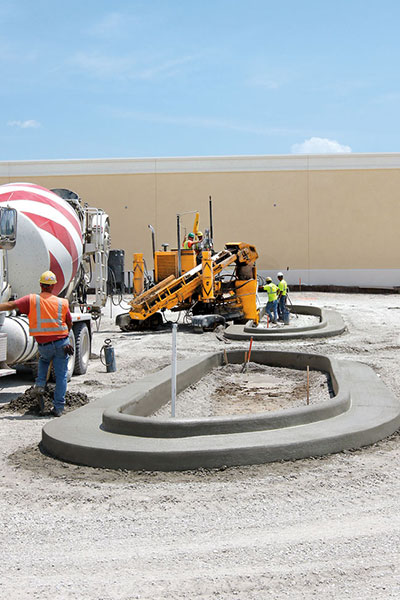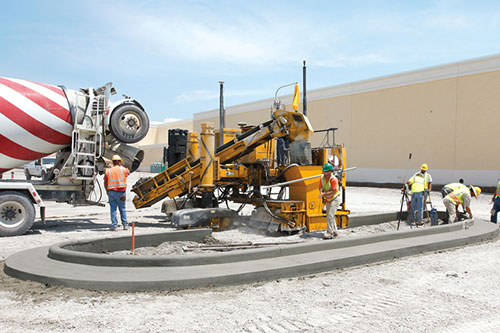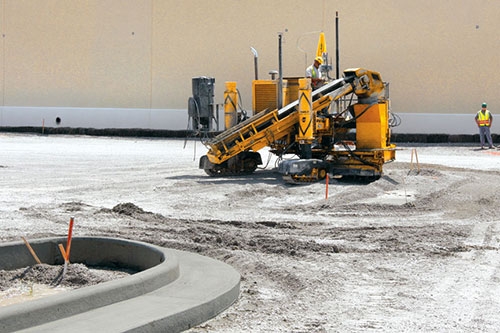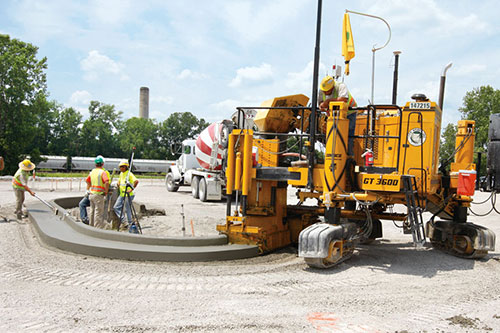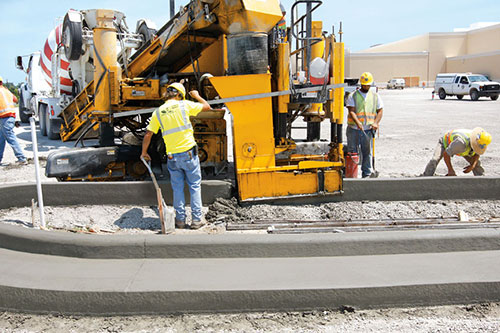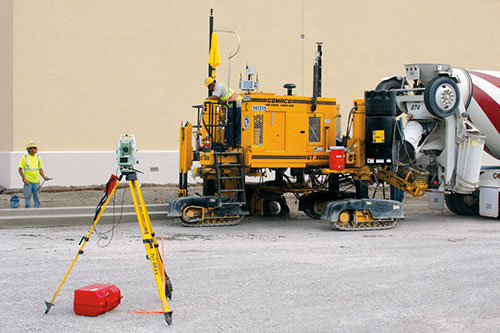GOMACO World Index --- GOMACO World 37.2 - September 2009
Stringless Curb and Gutter is Here!
Imagine... a GOMACO GT-3600 slipforming curb and gutter on a parking lot project. The parking lot has several islands built into its design with radii from 4.5 foot (1.4 m) down to 18 inches (457 mm). All of the radii on the islands are being slipformed with the GT-3600 and all of it is being done without setting any stringline.
The possibility is not left to the imagination anymore. Stringless curb and gutter is here!
The project is a parking lot for a new casino in the city of St. Louis, Missouri. Fred Weber, Inc., is slipforming approximately 14,000 feet (4267 m) of curb and gutter on the 50 acre (20.2 ha) lot. The curb and gutter’s profile is 30 inches wide (762 mm), seven inches (178 mm) thick, with a six inch (152 mm) curb.
The GT-3600 is equipped with the Leica PaveSmart 3D for curb and gutter slipform pavers, an optional plug and play software program available on GOMACO equipment. For this project, the GT-3600 is equipped with a prism on the rear mast, which a Total Station uses for height control, and also a GPS receiver on the front mast, which is used for machine orientation. The GPS unit can be switched over for a second Total Station if the area doesn’t allow GPS reception.
Here’s how stringless curb and gutter works: Data provided by the project engineer is converted into a surface model. The surface model is then uploaded into the Leica computer. The data can be imported from almost any CAD system. The Leica computer is then interfaced with the GOMACO G21 or optional G22 controller on the GT-3600. When it’s time to start slipforming, the operator simply opens up a map of the project on the Leica computer and chooses where he wants to go. The computer has a toggle switch or touch-screen interface, so it’s just a matter of pressing a button to chose where to pave. The GT-3600 is then moved into position.
The Total Station takes measurements off predetermined reference points to orientate its position. Then, it’s aimed at the prism on the machine and along with the GPS, begins the tracking process. The operator only has to look at the Leica computer to know that the GT-3600 is positioned correctly to begin the curb and gutter pour.
When it comes to slipforming the tight radii on the project, the Leica system and the GT-3600 work together.
“The Leica system is connected to the GT-3600’s G21 or G22 control system via the CAN (Controlled Access Network) cables, which are an integral part of each machine that GOMACO produces,” Kevin Klein, GOMACO’s Vice President of Engineering/Research and Development, said. “The Leica system contains the design file for the project which the contractor is building. As the Leica instruments track the machine, the exact position of the machine is sent to the Leica computer and that exact position is then compared to the project design file. From there, the Leica system places any relevant steering and grade control information onto the CAN line for the G21/G22 control system to capture and use in steering the machine, as well as maintaining the proper elevation.
“The operator can focus on control of the travel speed of the machine, controlling the vibration, and concrete delivery. The machine controller will take care of steering and grade, by monitoring the inputs from the 3D control system.”
Once an island is finished, the operator simply goes back to the map in the Leica computer, and chooses where he wants to go next. Or, for example, if an area isn’t ready for paving yet, because the grade isn’t prepared or some other factor, they can go anywhere else on the job site.
They are no longer dependent on stringline to dictate when and where they work. Workers on the project don’t have to worry about the stringline... setting it correctly, bumping into it and creating errors, or the time and expense of placing and removing it.
Fred Weber’s island production has drastically increased as well. Before, due to the expense of setting all of the pins required for tight island radii, they would have just handformed all of the islands.
“We would figure on finishing only two islands a day with handforming,” Billy Graves, Project Foreman for Fred Weber, said. “With GOMACO and Leica, we’re doing eight a day. It’s a big advantage for us and giving us some excellent production. We’re slipping the radii and the straight-aways and the Leica is doing a great job. We’re averaging around 18 feet (5.5 m) per minute with no string.”
Subscribe to Receive GOMACO World Magazine
